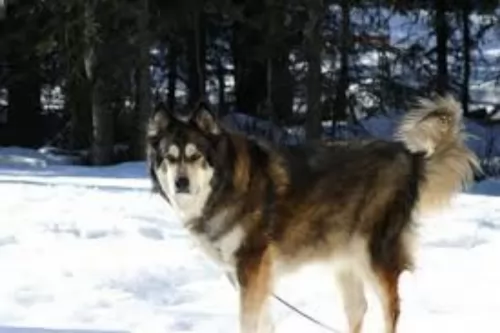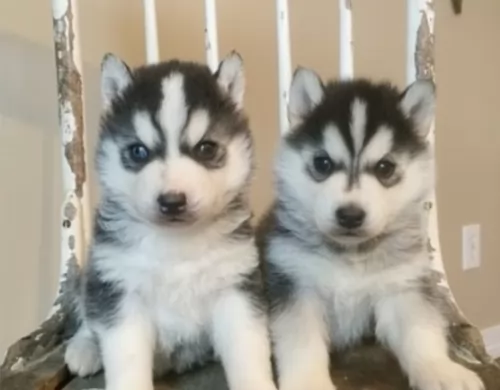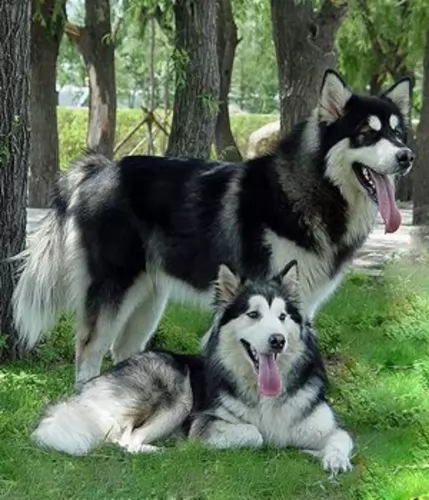 MyDogBreeds
MyDogBreeds Both Shepard Labrador and Mackenzie River Husky are originated from United States. Shepard Labrador may grow 12 cm / 4 inches shorter than Mackenzie River Husky. Shepard Labrador may weigh 11 kg / 24 pounds lesser than Mackenzie River Husky. Both Shepard Labrador and Mackenzie River Husky has same life span. Both Shepard Labrador and Mackenzie River Husky has same litter size. Shepard Labrador requires Low maintenance. But Mackenzie River Husky requires Moderate maintenance
Both Shepard Labrador and Mackenzie River Husky are originated from United States. Shepard Labrador may grow 12 cm / 4 inches shorter than Mackenzie River Husky. Shepard Labrador may weigh 11 kg / 24 pounds lesser than Mackenzie River Husky. Both Shepard Labrador and Mackenzie River Husky has same life span. Both Shepard Labrador and Mackenzie River Husky has same litter size. Shepard Labrador requires Low maintenance. But Mackenzie River Husky requires Moderate maintenance
 The Labrador/German Shepherd mix, known as the Shepard Labrador was no doubt first bred in the United States from two very popular dog breeds - the Labrador and the German Shepherd.
The Labrador/German Shepherd mix, known as the Shepard Labrador was no doubt first bred in the United States from two very popular dog breeds - the Labrador and the German Shepherd.
Breeders of this dog were looking to bring about a dog that could be an exceptional companion with characteristics from both breeds.
Also referred to as the Sheprador, the dog will surely have an amazing temperament.
 The name Mackenzie River Husky was given to these huskies by those wanting to name the freight huskies of a certain area. The name took hold in the 1960’s, but the dog began to disappear with the introduction of snow machines.
The name Mackenzie River Husky was given to these huskies by those wanting to name the freight huskies of a certain area. The name took hold in the 1960’s, but the dog began to disappear with the introduction of snow machines.
They’re a mixture of native sled dogs - Newfoundlands, St. Bernards, Staghounds and Wolf. As a mixed breed, they have always been regarded as classic sled dogs.
 With the Shepard Labrador, because the puppies come from two pure breeds – the Labrador and the German Shepherd, there is no really knowing how your pet will turn out. There is therefore no standard appearance.
With the Shepard Labrador, because the puppies come from two pure breeds – the Labrador and the German Shepherd, there is no really knowing how your pet will turn out. There is therefore no standard appearance.
Some will have floppy ears like the Labrador, some erect ears like the German Shepherd. The tail will always be long. The coat will always be thick and be short to medium in length. Some puppies will be born with a fawn shade and others will have the dark colors of the German Shepherd. Some will have a mix of colors.
They will be fairly large dogs standing at between 53 and 62m in height and weighing between 23 and 36kg.
Between two such splendid dog breeds, you’re guaranteed to get a wonderful temperament – after all, that's why the two breeds were brought together. Your Shepard Labrador will be friendly, playful, social,smart, courageous, loving, loyal and energetic, just loving to be around his human family.
These dogs get on well with children, and with training and socialization will get on well with other pets in the home. This dog really makes a splendid family pet.
 The beautiful Mackenzie River Husky stands at 66 to 74cm in height and weighs between 29 and 47kg.
The beautiful Mackenzie River Husky stands at 66 to 74cm in height and weighs between 29 and 47kg.
This deep chested dog has a long, straight coat with the colors being typically wolf-like – white, cream, black, tan, blonde and red. He has erect ears, long legs and a long, bushy tail.
This wolf-type dog is strong willed and independent and was always a pack dog. They wouldn’t be described as a good choice for the first time dog owner as they do seem to have some wolf traits and will require a strong, firm, level headed owner.
 There are studies that show that dogs provide us with so many good things – companionship, comfort and relaxation.They provide us with entertainment too because some of them are so amusing with their antics.
There are studies that show that dogs provide us with so many good things – companionship, comfort and relaxation.They provide us with entertainment too because some of them are so amusing with their antics.
The Shepard Labrador is like that – he is social, friendly, loving and devoted and by bringing him into your home, you’re signing up for 10 – 14 years of sheer pleasure, less stress and superb companionship.
 Your MacKenzie River Husky is such a likeable pet to have. True, he does tend to be a bit stubborn and independent but there is nothing that training and socialization won’t do for him. You’ll find him much more obedient and amicable, and he gets on well with children and pets in the home.
Your MacKenzie River Husky is such a likeable pet to have. True, he does tend to be a bit stubborn and independent but there is nothing that training and socialization won’t do for him. You’ll find him much more obedient and amicable, and he gets on well with children and pets in the home.
He is an intelligent dog too and very energetic so will require an owner who is active, firm and consistent. He thrives on human company and just wants to be around his owner all the time, ready to join in with any activity happening in his life.
He is therefore far more suited to life in the countryside than to the city. Loyal, devoted and loving, a MacKenzie River Husky isn’t only a beautiful dog to own, he promises to offer everything you want in a 4-legged friend.
 The Shepard Labrador is a healthy dog breed, and with the right nutrition and exercise can reach 10 to 14 years of age. There are always going to be those common dog illnesses that many dogs succumb to. Some of them are hip dysplasia, cancer, skin problems and parasites.
The Shepard Labrador is a healthy dog breed, and with the right nutrition and exercise can reach 10 to 14 years of age. There are always going to be those common dog illnesses that many dogs succumb to. Some of them are hip dysplasia, cancer, skin problems and parasites.
Hip dysplasia is a condition where parts of the hip joints don’t fit properly together. This creates a situation where there is abnormal wear and tear on the joints. It can lead to arthritis even and pain for your dog.
The tapeworm is a parasite spread to dogs but also to people, and it is through the ingestion of infected fleas. You can often detect this when you discover parts of the worm crawling in your dog’s bowel movements or they can be around the anus. You can suspect this when you see your pet losing weight and having diarrhea. Speak to your vet about how to control fleas with your dog.
This is a fatal disease where dogs are infected through bites from rabid animals. You’ll notice horrible behavioral changes in your dog. Unfortunately with this terrible disease, once symptoms appear, it is virtually too late for treatment.
 Your MacKenzie River Husky, regardless of how healthy he is, can suffer with some common health problems that all dogs are prone to.
Your MacKenzie River Husky, regardless of how healthy he is, can suffer with some common health problems that all dogs are prone to.
Perhaps one of the more common health problems that this particular dog breed has to contend with is cataracts, hip dyslasia and hypothyroidism.
Many people associate cataracts in dogs with age, little realizing that there are many medical reasons as to why our pets develop cataracts. Cataracts can start as early as 6 months of age, although this is unlikely. They come about because of a disease which affects the lens of the eye, causing the lens to lose its transparency.
You’ll notice a whitish/grey shade in your dog’s eye and this can actually impair vision. Cataracts are particularly the lot of diabetic dogs. It can certainly help to have your dog’s eyes checked by a vet regularly.
This is another fairly common problem with Huskies. It’s almost like a death sentence if your MacKenzie is a working dog because it can lead to lameness. The disease can lead to problems in the hip joint which cab be debilitating ad give your dog a lot of pain.
It doesn’t strike old dogs only, but can be the lot of young dogs too. Sometimes treatment will require surgery but there are non-invasive options too. You want to make sure that you don’t allow your pet to become overweight as this can contribute to developing hip dysplasia.
 ◆Brush the coat of your Shepard Labrador twice a week to rid the coat of loose hairs and to keep the coat shiny ad healthy. Many people add in the Omega 3/6 oils to the dog’s food to ensure a healthy skin and coat.
◆Brush the coat of your Shepard Labrador twice a week to rid the coat of loose hairs and to keep the coat shiny ad healthy. Many people add in the Omega 3/6 oils to the dog’s food to ensure a healthy skin and coat.
◆Check the ears and eyes for infection. Make sure there are no signs of redness and discharge.
◆Check the inside of your pet’s mouth He has no way of telling you that a rotten tooth in the mouth is causing hi tremendous pain and affecting the his health.
◆Provide your pet with a warm, dry place to sleep. Make sure if he is outdoors that he has both sun and shade.
◆Feed your pet the best food there is. Your Shepard Labrador will no doubt be served commercially manufactured food. There are good and bad varieties. Make sure it is one of the better brands to ensure you don’t end up feeding your pet foods packed full of unhealthy ingredients such as colorants, preservative and fillers.
Try and include some home-made food to the diet. Boiled chicken, brown rice or pasta and spinach, sweet potatoes and carrots are a healthy choice for your pet as it won’t upset your dog’s digestive system.
Also try and include some raw meat into the diet as this can help in fighting off skin problems. Ensure your Shepard Labrador always has access to a bowl of fresh, cool water.
 Huskies like this one will require a good deal of exercise every single day. These are working dogs who have always had a job to do and you can certainly count him in when you do your hiking walks, swimming – you name it. The only thing he will object to is that he doesn’t do well in hot weather. Strong-willed, you’ll want your MacKenzie River Husky trained and socialized if you want him to be a companionable dog.
Huskies like this one will require a good deal of exercise every single day. These are working dogs who have always had a job to do and you can certainly count him in when you do your hiking walks, swimming – you name it. The only thing he will object to is that he doesn’t do well in hot weather. Strong-willed, you’ll want your MacKenzie River Husky trained and socialized if you want him to be a companionable dog.
Dogs need to be fed according to the size, their age and their lifestyle. If your MacKenzie River Husky is an active working dog, his food must be the very best and contain enough calories to cover the daily caloric expenses.
Quality and the amount of vitamins and minerals in the food is most important for a dog like this. If you feed him commercially manufactured food, make sure its high quality and not made up of fillers, and other bad stuff. Read the label and understand exactly what’s going into your dog’s stomach.
Simplicity with feeding is best for your pet. Treat him occasionally to cooked chicken, brown rice, pasta and cooked or raw vegetables which can be added into his dry kibble. A dog like this will require some raw meat as well to ensure his coat and eyes are always shiny and bright.
Grooming of the MacKenzie River Husky must be done at least twice a week to get rid of loose hairs.